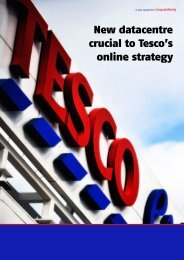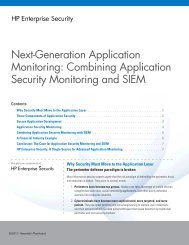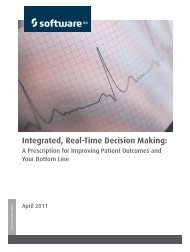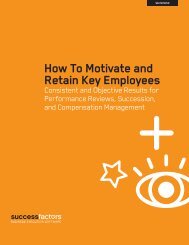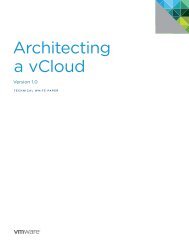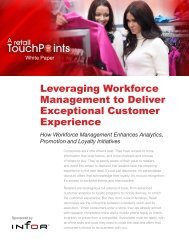Market Insight: The Impact of Cloud Computing in Retail - Bitpipe
Market Insight: The Impact of Cloud Computing in Retail - Bitpipe
Market Insight: The Impact of Cloud Computing in Retail - Bitpipe
Create successful ePaper yourself
Turn your PDF publications into a flip-book with our unique Google optimized e-Paper software.
<strong>Market</strong> <strong>Insight</strong>: <strong>The</strong> <strong>Impact</strong> <strong>of</strong> <strong>Cloud</strong> <strong>Comput<strong>in</strong>g</strong> <strong>in</strong> <strong>Retail</strong><br />
By Jeffrey Roster, research vice-president, Gartner<br />
<strong>Retail</strong>, like virtually all other <strong>in</strong>dustries, is awash with stories about the emergence <strong>of</strong> cloud comput<strong>in</strong>g. Much has<br />
been written about the ability to remove cost or to greatly speed up implementations. However, the retail executive<br />
tends to be very sceptical <strong>of</strong> such claims. Early w<strong>in</strong>s for SaaS <strong>in</strong>itiatives are largely based on BI and analytics<br />
<strong>in</strong>itiatives. However, these early efforts were not so much about develop<strong>in</strong>g a transformational approach to<br />
s<strong>of</strong>tware as they were a way <strong>of</strong> gett<strong>in</strong>g pro<strong>of</strong>s <strong>of</strong> concepts launched. Many <strong>of</strong> these pro<strong>of</strong>s <strong>of</strong> concepts have now<br />
emerged as fully operational projects, while still operat<strong>in</strong>g <strong>in</strong> a SaaS model. From this small base, the <strong>in</strong>dustry<br />
could potentially greatly expand its use <strong>of</strong> the cloud, thereby creat<strong>in</strong>g opportunities for T&SPs and rattl<strong>in</strong>g longstand<strong>in</strong>g<br />
s<strong>of</strong>tware dynasties based on classic s<strong>of</strong>tware licens<strong>in</strong>g models.<br />
Industry Drivers <strong>of</strong> <strong>Cloud</strong> Adoption<br />
What are the major issues push<strong>in</strong>g retail decision makers toward cloud comput<strong>in</strong>g?<br />
<strong>The</strong> key early successes for cloud-comput<strong>in</strong>g solutions <strong>in</strong> retail have been based around critical retail<br />
functionalities. To date, there's been a limited number <strong>of</strong> w<strong>in</strong>s. Still, the future looks bright for cloud <strong>of</strong>fer<strong>in</strong>gs. A<br />
recent Gartner survey <strong>in</strong>dicated that by 2012, 19.7% <strong>of</strong> retailers expect to acquire the majority <strong>of</strong> their hardware<br />
and s<strong>of</strong>tware assets through technology-as-a-service <strong>of</strong>fer<strong>in</strong>gs. That's a significant level <strong>of</strong> <strong>in</strong>crease from where<br />
retail is today.<br />
<strong>The</strong> follow<strong>in</strong>g is driv<strong>in</strong>g this grow<strong>in</strong>g <strong>in</strong>terest <strong>in</strong> cloud:<br />
• Rapid deployment <strong>of</strong> needed functionality — Whether it's a new mobile-commerce solution, new analytic<br />
packages or a Web-based plann<strong>in</strong>g tool, retail technologists understand that they need to enable needed<br />
functionality <strong>in</strong> weeks and months, not years.<br />
• Lower-cost operat<strong>in</strong>g models — Few retail CIOs expect to see any significant <strong>in</strong>crease <strong>in</strong> their IT budgets<br />
for the near future. But the pace <strong>of</strong> new IT <strong>in</strong>itiatives to support rapidly evolv<strong>in</strong>g bus<strong>in</strong>ess models is actually<br />
accelerat<strong>in</strong>g, forc<strong>in</strong>g retailers to re-evaluate how IT spend<strong>in</strong>g is allocated.<br />
• Scalable across many locations — <strong>The</strong> emergence <strong>of</strong> mobile commerce and social media as a high-priority<br />
bus<strong>in</strong>ess <strong>in</strong>itiative is driv<strong>in</strong>g more IT assets to the store. However, a Tier 1 retailer can have thousands <strong>of</strong><br />
stores, mak<strong>in</strong>g traditional s<strong>of</strong>tware model far too expensive to ma<strong>in</strong>ta<strong>in</strong>.<br />
• Ability to use operation budget versus capital spend<strong>in</strong>g — One result <strong>of</strong> the "Great Recession" has been<br />
that virtually all capital expenditure (capex) spend<strong>in</strong>g has undergone tremendous scrut<strong>in</strong>y. <strong>Cloud</strong>comput<strong>in</strong>g<br />
models can turn those capex projects <strong>in</strong>to operations budget expenditures, allow<strong>in</strong>g them to<br />
launch under much less scrut<strong>in</strong>y.<br />
<strong>Impact</strong> on Vendor Product Managers or Vendor <strong>Market</strong><strong>in</strong>g<br />
<strong>Cloud</strong> comput<strong>in</strong>g <strong>of</strong>fers retailers the ability to free themselves from the burden <strong>of</strong> crippl<strong>in</strong>g <strong>in</strong>tegration costs, legacy<br />
applications and speed to market with new functionality. That's clearly a very attractive message for an <strong>in</strong>dustry<br />
struggl<strong>in</strong>g to catch up to the sophistication <strong>of</strong> a typical customer, who will most likely have more comput<strong>in</strong>g power <strong>in</strong><br />
his or her hands than the store associate serv<strong>in</strong>g them. However, retailers have a history <strong>of</strong> adopt<strong>in</strong>g technology<br />
very slowly and methodically. Product managers develop<strong>in</strong>g strategies for cloud solutions need to align their<br />
market<strong>in</strong>g messages to the key drivers outl<strong>in</strong>ed above. It's critical to understand that few. are look<strong>in</strong>g to pilot the<br />
next breakthrough technology rather preferr<strong>in</strong>g technology that has stabilized.
Industry Inhibitors to <strong>Cloud</strong> Deployment<br />
<strong>The</strong> largest barrier to cloud adoption could very possibly be def<strong>in</strong>itional. It is still early <strong>in</strong> the adoption cycle for cloud<br />
services <strong>in</strong> retail, but the <strong>in</strong>dustry is catch<strong>in</strong>g on fast. In the 2010 Gartner/RIS News retail sector survey, 24% <strong>of</strong> the<br />
respondents <strong>in</strong>dicated <strong>in</strong>terest <strong>in</strong> acquir<strong>in</strong>g s<strong>of</strong>tware via a SaaS model, while 11% <strong>in</strong>dicated <strong>in</strong>terest <strong>in</strong> cloud<br />
comput<strong>in</strong>g. <strong>The</strong> difference here is simply how one def<strong>in</strong>es the cloud. Gartner considers SaaS to be a component <strong>of</strong><br />
cloud services. Additional barriers to adoption <strong>of</strong> cloud comput<strong>in</strong>g <strong>in</strong> retail <strong>in</strong>clude:<br />
• <strong>The</strong> risk-averse nature <strong>of</strong> the retail <strong>in</strong>dustry — Few retailers want to be early adopters <strong>of</strong> any technology.<br />
<strong>The</strong>y perceive little value <strong>in</strong> tak<strong>in</strong>g those risks.<br />
• Security — This is the major issue prevent<strong>in</strong>g large-scale adoption <strong>of</strong> cloud services <strong>in</strong> the retail sector.<br />
Many retailers still believe that shift<strong>in</strong>g more data to the cloud will <strong>in</strong>crease the risk <strong>of</strong> stolen <strong>in</strong>formation<br />
and other disruptions.<br />
• No immediate perceived improvement <strong>in</strong> functionality — A major challenge gett<strong>in</strong>g <strong>in</strong>frastructure as a<br />
service (IaaS) and portfolio as a service (PaaS) pilot projects launched is that driv<strong>in</strong>g a cost conta<strong>in</strong>ment<br />
strategy that doesn't provide an immediate improvement <strong>in</strong> a customer-fac<strong>in</strong>g application. Without a<br />
bus<strong>in</strong>ess unit champion that can tie these <strong>in</strong>itiatives to improved customer experiences, they will have<br />
difficulty gett<strong>in</strong>g to the fund<strong>in</strong>g stage.<br />
• Loss <strong>of</strong> perceived control over IT assets— <strong>Retail</strong>ers have a historic aversion to giv<strong>in</strong>g up control <strong>of</strong> their IT<br />
assets. Unfortunately, cloud projects hit directly on this long-stand<strong>in</strong>g retail <strong>in</strong>security.<br />
<strong>Impact</strong> on Vendor Product Managers or Vendor <strong>Market</strong><strong>in</strong>g Executives<br />
Given the massive amount <strong>of</strong> buzz that cloud comput<strong>in</strong>g has generated, product managers and market<strong>in</strong>g<br />
executives could believe the retail <strong>in</strong>dustry is ready to adopt cloud solutions on a widespread scale. That would be<br />
a mistake. Given the early nature <strong>of</strong> cloud comput<strong>in</strong>g <strong>in</strong> retail and the <strong>in</strong>dustry's conservative approach to<br />
technology adoption, the <strong>in</strong>hibitors will block a sale if not properly overcome. Technology and service providers<br />
need to create market<strong>in</strong>g messages and campaigns designed to overcome each <strong>of</strong> the <strong>in</strong>hibitors identified above.<br />
<strong>The</strong> <strong>in</strong>hibitors are <strong>in</strong>itially stronger than the drivers.<br />
<strong>The</strong> bottom l<strong>in</strong>e is that cost removal is an attractive story, but a perceived security flaw <strong>in</strong> the solution will elim<strong>in</strong>ate<br />
any possible advantage. <strong>Retail</strong> executives, as a whole, are extremely risk-averse and are look<strong>in</strong>g for a reason to<br />
say no to any new technology <strong>in</strong>itiative. Sales strategies can and should have a dual focus. <strong>The</strong> bus<strong>in</strong>ess unit<br />
executive is strictly look<strong>in</strong>g at functionality improvements. This group isn't as risk-averse or as worried about<br />
security as the CIO. But without a champion <strong>in</strong> this group, no <strong>in</strong>itiative can move forward. <strong>The</strong> IT team is worried<br />
about security and loss <strong>of</strong> control. <strong>Market</strong><strong>in</strong>g messages need to be tailored to each group for success <strong>in</strong> retail.<br />
Near-Term and Long-Term Opportunities for <strong>Cloud</strong> <strong>Comput<strong>in</strong>g</strong> <strong>in</strong> <strong>Retail</strong><br />
Which aspect <strong>of</strong> the cloud-comput<strong>in</strong>g market represents the most important areas <strong>of</strong> retail deployment?<br />
Gartner sees three dist<strong>in</strong>ct aspects <strong>of</strong> cloud comput<strong>in</strong>g to be SaaS, IaaS and PaaS. All three can and, most likely,<br />
will ultimately impact the retail <strong>in</strong>dustry. But <strong>in</strong> retail, SaaS has taken hold as the other two struggle to ga<strong>in</strong><br />
significant m<strong>in</strong>d share with bus<strong>in</strong>ess unit leaders as well as with CIOs. This is based on a classic retail adoption<br />
pattern <strong>of</strong> go<strong>in</strong>g after functionality that impacts customer experience rather than <strong>in</strong>vestments <strong>in</strong> non differentiat<strong>in</strong>g<br />
<strong>in</strong>frastructure. For IaaS and PaaS to catch on, there needs to be significant cost-reduction ga<strong>in</strong>s. If not, retailers will<br />
pass on these <strong>in</strong>vestments <strong>in</strong> lieu <strong>of</strong> more-promis<strong>in</strong>g opportunities <strong>in</strong> customer-fac<strong>in</strong>g <strong>in</strong>itiatives or analytics tools<br />
that provide <strong>in</strong>sights <strong>in</strong>to senior retail executives .<br />
To date the functionality retailers are look<strong>in</strong>g for consists <strong>of</strong> merchandis<strong>in</strong>g, BI and e-commerce.
CONCLUSION<br />
Product managers at T&SP firms have a unique opportunity to br<strong>in</strong>g a set <strong>of</strong> <strong>in</strong>novative solutions to market at a<br />
time when retailers are ready to embrace new delivery systems. <strong>The</strong> key message for them to lead with is that<br />
cloud solutions <strong>of</strong>fer speed to market with new functionality around retail processes such as merchandis<strong>in</strong>g, BI and<br />
workforce management. This way, critical support from bus<strong>in</strong>ess unit leaders can be obta<strong>in</strong>ed. Cost reduction is an<br />
important support<strong>in</strong>g strategy for the bus<strong>in</strong>ess case justification, but <strong>in</strong> most cases it will not be the dom<strong>in</strong>ant driver.<br />
F<strong>in</strong>ally, security will be a key obstacle to overcome.








